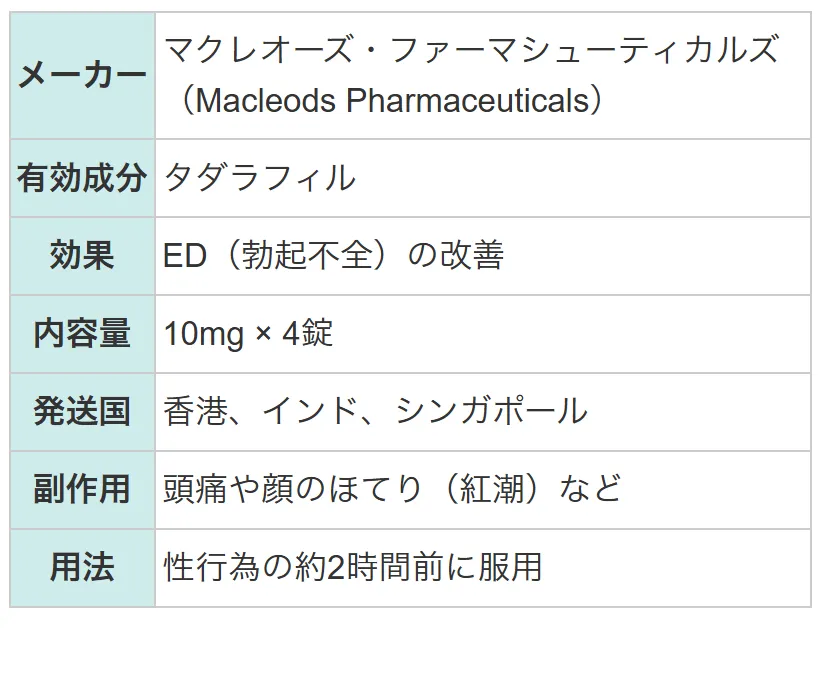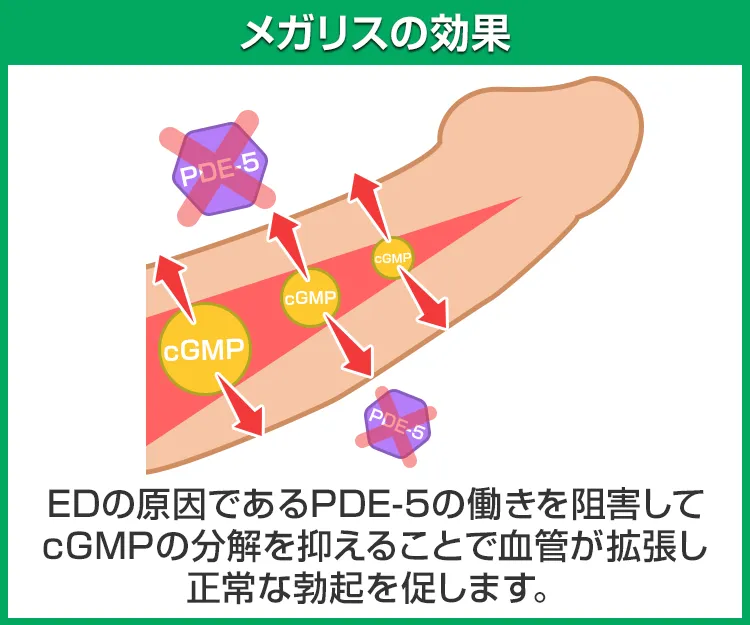| 1日の服用回数 | 1回 |
|---|
| 1回の服用量 | 10~20mg |
|---|
| 服用のタイミング | 性行為の約2時間前 |
|---|
| 服用間隔 | 24時間 |
|---|
メガリスは
性行為の約2時間前に水やぬるま湯で服用します。
1回あたりの服用量は10mg錠の場合は1~2錠もしくは20mg錠を1/2~1錠(タダラフィルとして10~20mg)となっています。
ただし、初めてメガリスを服用する時は最少用量である10mg錠を1錠もしくは20mg錠を1/2錠から開始します。その上で、効果や副作用を確認しながら次回以降の服用量を増量するか検討してください。
メガリスは1回の服用量に関わらず1日の服用回数は1回までとなっています。そのため、1回服用した後は24時間以上の間隔をあけて服用するようにしてください。
メガリスを服用する際の注意点
メガリスを軽度又は中等度の肝障害がある方が服用する場合、
10mg錠を1錠もしくは20mg錠を1/2錠が上限の服用量となります。
中等度又は重度の腎障害のある方の場合、
初回服用量を10mg錠を1/2錠もしくは20mg錠を1/4錠(バルデナフィルとして5mg)とし、
10mg錠を1錠もしくは20mg錠を1/2錠が上限となります。
さらに上限の服用量を服用した場合、次の服用をするまでに48時間以上の時間を空けるようにしてください。また、重度の腎障害のある方が服用する場合の
上限量は10mg錠を1/2錠もしくは20mg錠を1/4錠となっています。
メガリスは他のED治療薬と比べて食事の影響を受けにくくなっていますが、全く受けないわけではありません。そのため、
効果を最大限に引き出すためには適切な空腹時に用法用量を守ってお使いください。
また、過度な飲酒は効果を弱めたり副作用のリスクを高めてしまうことがあるため、
服用後の飲酒にも注意が必要です。
| | 1%以上 | 0.2〜1%未満 | 0.2%未満 | 頻度不明 |
| 循環器 | 潮紅 | 動悸、ほてり | 血管拡張、心拍数増加、胸痛、狭心症、頻脈、高血圧、低血圧 | 心筋梗塞、心臓突然死、失神、起立性低血圧 |
| 感覚器 | | 霧視、眼の充血、眼の異常感 | 耳鳴、視覚障害、眼痛、流涙増加、眼刺激、結膜充血、視野欠損、結膜炎、乾性角結膜炎、眼瞼腫脹 | 色覚変化、回転性眩暈、網膜静脈閉塞、非動脈炎性前部虚血性視神経症、網膜動脈閉塞、中心性漿液性脈絡網膜症 |
| 消化器 | 消化不良 | 上腹部痛、悪心、胃食道逆流性疾患、下痢、口内乾燥、胃炎、嘔吐、腹痛、胃(胸部)不快感 | 便秘、腹部膨満、軟便、胃刺激症状、嚥下障害 | 食道炎 |
| 肝臓 | | 肝機能異常(AST上昇、ALT上昇、γ-GTP上昇を含む) | ALP上昇 | |
| 腎臓 | | | 腎機能障害、尿酸値上昇 | |
| 筋骨格 | 背部痛、筋痛、四肢痛 | 関節痛、筋痙攣(筋収縮)、筋骨格痛 | 筋骨格硬直、頚部痛、殿部痛 | |
| 精神・神経系 | 頭痛 | めまい、睡眠障害 | 錯感覚、傾眠、不安、片頭痛 | 脳卒中、感覚鈍麻 |
| 泌尿・生殖器 | | | 排尿困難、勃起増強、意図しない勃起 | 持続勃起症、勃起の延長 |
| 呼吸器 | 鼻閉 | 鼻炎、副鼻腔うっ血 | 呼吸困難、喀血 | 鼻出血、咽頭炎 |
| 皮膚 | | | 紅斑、多汗、爪囲炎 | そう痒症 |
| その他 | | 疲労、無力症、疼痛、体重増加、倦怠感 | 熱感、末梢性浮腫、粘膜浮腫、口渇 | |
比較的副作用は少ないとされていますが、紅潮、消化不良、頭痛といった症状が起こる恐れがあります。
ただし、これらの症状は時間の経過とともに消失します。
服用方法や副作用・併用禁忌・注意のご説明には、商品の説明書の他に、次のサイトを参考にしています。
医療用医薬品 :シアリス添付文書 :シアリス
パッケージ例となります。
商品やご注文単位によってはシート単位でのお届けとなる場合が御座います。
外箱に当サイト名や商品名が記載されることはないため、ご家族や配達員など第三者に内容を知られることは御座いません。
















































商品口コミの投稿は会員のみ行えるようになっております。
お手数ですが会員ログインの上でご投稿頂きますようお願いいたします。
口コミをご投稿頂いたお客様にはポイントをプレゼントさせて頂いております。
文章のみであれば100ポイント、文章+写真付きのものは300ポイントをプレゼントさせて頂きます。
規約や詳細などはこちらをご確認くださいませ。